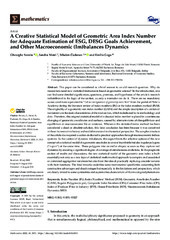Please use this identifier to cite or link to this item:
https://rfos.fon.bg.ac.rs/handle/123456789/2316Full metadata record
| DC Field | Value | Language |
|---|---|---|
| dc.creator | Savoiu, Gheorghe | |
| dc.creator | Matei, Sandra | |
| dc.creator | Čudanov, Mladen | |
| dc.creator | Gogu, Emilia | |
| dc.date.accessioned | 2023-05-12T11:41:20Z | - |
| dc.date.available | 2023-05-12T11:41:20Z | - |
| dc.date.issued | 2022 | |
| dc.identifier.issn | 2227-7390 | |
| dc.identifier.uri | https://rfos.fon.bg.ac.rs/handle/123456789/2316 | - |
| dc.description.abstract | This paper can be considered as a brief answer to an old research question. Why do researchers need new statistical instruments based on geometric science? In the introduction, one can find some detailed significances, questions, premises, and hypotheses of the article's research redistributed in the logic of the section, as only a reminder can do it. There are no mandatory access conditions equivalent to "Let no one ignorant of geometry enter here" from the portal of Plato' s Academy during the literature review of index numbers (IN) or the index numbers method (INM). The originality of a geometric area index number (GAIN) and the simple description of a statistical instrument are the main characteristics of the next section, which is dedicated to its methodology and data. Therefore, this original statistical model of a classical index number is placed in a continuous changing of geometric coordinates and surfaces, caused by alternate states of disequilibrium and equilibrium in macroeconomic life or existence. Whenever the statistical index method has been considered a dead or obsolete solution, this false conclusion has been because it was conceived without its innovative history and multidimensional mathematical perspective. The complex structure of the article also required a section dedicated to practical approaches through macroeconomic indices systems. In the context of dynamic imbalances, this aspect limits the selective options of the new concept of a statistical model of a geometric area index to several inscribable but also regular polygons ("n-gons") at the same time. These polygons take on stellar shapes as soon as they capture real dynamics by ensuring a significant degree of coverage of simultaneous evolutions. In the pragmatic section of results and discussions, the new statistical model of the geometric area index is built essentially not only as a new type of statistical-mathematical approach to complex and associated or correlated aggregative variations but also from the idea of practically replacing concrete variants with their functions. The final remarks underline some instrumental specificities concerning both constructive advantages and disadvantages but especially to the limitations and perspectives, which are closely related to some symmetries and asymmetries characteristic of the investigated phenomena. | en |
| dc.publisher | MDPI, Basel | |
| dc.rights | openAccess | |
| dc.rights.uri | https://creativecommons.org/licenses/by/4.0/ | |
| dc.source | Mathematics | |
| dc.subject | Regular Polygons (n-gon) | en |
| dc.subject | Macroeconomic Imbalances Dynamics (MID) | en |
| dc.subject | Index of Producer Price in Industry (IPPI) | en |
| dc.subject | Index Numbers' Method (INM) | en |
| dc.subject | Index Number (IN) | en |
| dc.subject | House Price Index (HPI) | en |
| dc.subject | Geometric Area Index Number (GAIN) | en |
| dc.subject | Consumer Price Index (CPI) | en |
| dc.subject | Composite Index Numbers (CIN) | en |
| dc.title | A Creative Statistical Model of Geometric Area Index Number for Adequate Estimation of ESG, DESG Goals Achievement, and Other Macroeconomic (Im)balances Dynamics | en |
| dc.type | article | |
| dc.rights.license | BY | |
| dc.citation.issue | 16 | |
| dc.citation.other | 10(16): - | |
| dc.citation.rank | aM21~ | |
| dc.citation.volume | 10 | |
| dc.identifier.doi | 10.3390/math10162853 | |
| dc.identifier.fulltext | http://prototype2.rcub.bg.ac.rs/bitstream/id/840/2312.pdf | |
| dc.identifier.rcub | conv_2754 | |
| dc.identifier.scopus | 2-s2.0-85137412422 | |
| dc.identifier.wos | 000846638200001 | |
| dc.type.version | publishedVersion | |
| item.cerifentitytype | Publications | - |
| item.fulltext | With Fulltext | - |
| item.grantfulltext | open | - |
| item.openairetype | article | - |
| item.openairecristype | http://purl.org/coar/resource_type/c_18cf | - |
| Appears in Collections: | Radovi istraživača / Researchers’ publications | |
This item is licensed under a Creative Commons License


